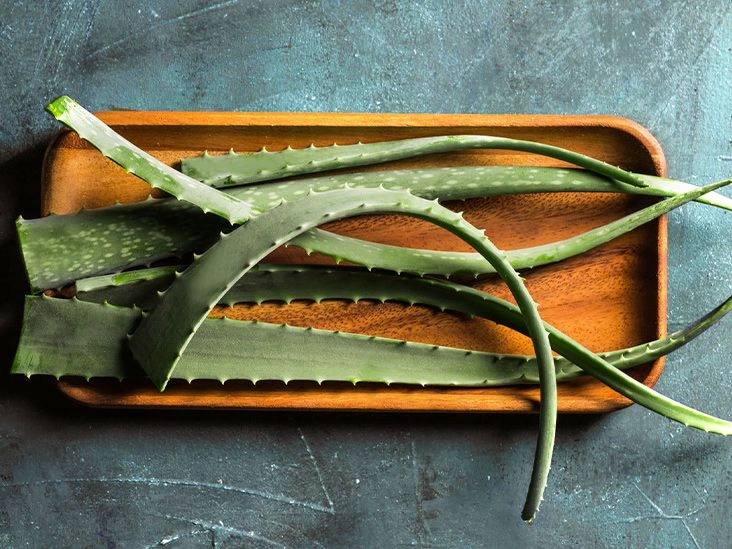The aloe vera plant is a succulent that stores water in its leaves as a clear gel. This gel is highly hydrating and ideal for soothing sunburns, insect bites, small cuts or abrasions, and other skin complaints.

Many commercial aloe vera products include potentially unhealthy additives like colorants. This article shows how to quickly prepare aloe vera gel at home using fresh aloe leaves.
What you’ll need
Homemade aloe vera gel is simple to produce using leaves from an aloe plant you keep at home or leaves bought from a grocery store or farmers market.
To make aloe vera gel, gather:
- an aloe vera leaf
- a knife or vegetable peeler
- a small spoon
- a blender
- An airtight container for storage
- powdered vitamin C and/or vitamin E (optional)
It’s best to process only one or two leaves at a time, since the fresh gel typically lasts about a week without added preservatives.
If you want to store it for longer, you’ll need to freeze it or incorporate a preservative such as powdered vitamin C or E.
SummaryTo make aloe vera gel you’ll need common kitchen tools, an aloe leaf, and — optionally — powdered vitamin C and/or vitamin E.
Step-by-step directions
Once you’ve gathered your supplies, making your aloe gel takes roughly 30 minutes.
1. Prepare the aloe leaves
When using a fresh leaf from a plant, cut one of the outermost leaves near the plant’s base.
You may also use a leaf purchased from a store.
Clean it thoroughly to remove soil, then stand it upright in a cup or bowl for 10–15 minutes. This allows the yellowish resin to drain from the leaf.
The resin contains latex, which may irritate skin, so this draining step is important.
After the resin has drained, rinse away any residue and remove the thick outer skin using a small knife or vegetable peeler.
2. Make the gel
With the leaf peeled, you’ll reveal the clear aloe vera gel inside.
Use a small spoon to scoop the gel into your blender, taking care not to include any pieces of the skin.
Blend until frothy and smooth; this only takes a few seconds.
Your gel is now ready to use, but if you want it to keep beyond one week, consider adding preservatives.
3. Add preservatives (optional)
Vitamins C and E serve as effective preservatives that can substantially extend the shelf life of homemade aloe gel.
Although aloe naturally contains some of these vitamins, the amounts aren’t sufficient to preserve the gel for more than about a week.
Adding additional vitamin C or E can prolong the gel’s usable life.
Both vitamins also have antioxidant and anti-aging benefits, which can enhance the skin-protective effects of your gel.
For every 1/4 cup (60 ml) of aloe gel, add 500 mg of powdered vitamin C or 400 International Units (IU) of powdered vitamin E — or both.
Simply add the powdered vitamins to the blender and mix again until they are fully dissolved into the gel.
Storage instructions
Fresh aloe vera gel without added vitamin C or E can be stored in the refrigerator in an airtight jar for up to one week.
Adding one or both vitamins greatly increases the shelf life to about two months in the fridge.
You can also freeze aloe gel in small portions — for example, in an ice cube tray — to have ready-to-use amounts on hand. Frozen aloe gel will keep in the freezer for up to six months.
SummaryTo prepare aloe vera gel: ready the leaves, scoop out the inner gel, blend it, and add preservatives if you want longer storage.
How to use aloe vera gel
Aloe vera gel can be applied directly to skin to address immediate skincare issues like sunburn, small cuts, and irritation.
It’s a great moisturizer for the face and hands and can create a mild antibacterial barrier for minor wounds.
Additionally, its antioxidant qualities may help shield skin from the harmful effects of excessive sun exposure, which is why it’s often used for sunburn relief.
Aloe is rich in distinctive polysaccharides — long chains of natural sugars — that researchers believe contribute to its skin-repairing effects.
It also contains various vitamins and minerals, including vitamins A, C, and E, which can support wound healing and overall skin health.
SummaryAloe vera gel can be applied straight to the skin to provide hydration, aid minor wound healing, and relieve sunburns and irritation.
Final thoughts
Aloe vera gel is an excellent skin moisturizer that may assist in healing and preventing skin damage.
Making it at home is a natural alternative to store-bought products, which can include undesirable additives.
It’s simple to craft this nourishing gel using fresh aloe leaves, a blender, and a knife or vegetable peeler.


















Leave a Reply
You must be logged in to post a comment.